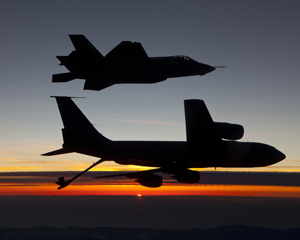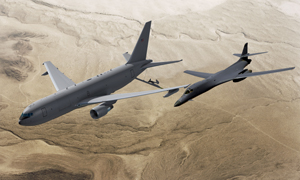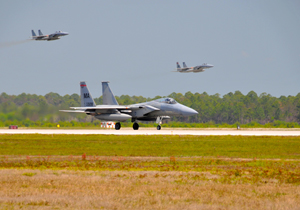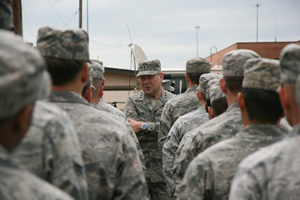In the movie “Apollo 13,” NASA Flight Director Gene Kranz, trying to get a handle on an unfolding space disaster and frustrated by a quickly mounting list of critical problems and system failures, demands of his controllers a positive status report. “What have we got on the spacecraft that’s good?” he asks.
Given the budgetary body blows dealt the Air Force in this and the past few years—hundreds of aircraft prematurely retired, thousands of personnel to be separated, and numerous important programs postponed or terminated outright—many are asking a similar question about USAF’s future.
The surprising answer is: quite a lot.

| ||
|
An F-35 and KC-135 rendezvous over Edwards AFB, Calif., on the F-35’s first night refueling mission on March 22. (Lockheed Martin photop) |
Air Force leaders say while these are indeed Spartan times, and force structure is coming down to historically low levels, the service’s bedrock modernization programs remain largely intact and will continue, though slowly. They insist the Air Force will remain capable of performing whatever missions it may be assigned in the coming decade.
Gen. G. Michael Hostage, head of Air Combat Command, said in an April speech that even if USAF eventually bears grave cuts amounting to 18 to 20 percent of last year’s budget, “that will still leave the Air Force at a $100 billion force … still the most powerful Air Force on the planet,” able to take on missions with greater “quantity and quality” than any other.
“We won’t go as many places and we won’t stay as long,” Hostage added, “but we still have that capability.”
“You needn’t worry about the health and safety of the Air Force,” he added, provided the modernization program now on the books is allowed to play out and service leaders succeed in preventing the retained force from being hollowed out.
The new national strategy is part of the reason USAF has fared reasonably well with its core programs, said Lt. Gen. Christopher D. Miller, deputy chief of staff for strategic plans and programs. The strategy elevates the importance of the Air Force since it emphasizes a swing toward the Pacific; long-range intelligence, surveillance, and reconnaissance; and the ability to defeat anti-access, area-denial measures (A2/AD). USAF’s capabilities in global reach, ISR, and stealth are tailor-made for the new strategy.
A2/AD Proliferation
“I think the new strategy is very positive for us,” Miller said in an interview, because it matches well with USAF’s strengths. Moreover, “it doesn’t dismiss or minimize what we have done in the last decade in the wars in Iraq and Afghanistan.” The investments made in ISR—such as in remotely piloted aircraft, as well as “joint operations and … in air [operations] command and control … will be sustained in this budget and on out,” he said.
However, the strategy also “focuses us back on the fact that we have to equip and train for the more challenging end of the spectrum,” namely, capabilities against a near-peer power with modern A2/AD capabilities.
Thus, while all the services saw some cherished programs deferred or terminated in recent years, the Air Force’s key modernization programs—F-35 fighters, KC-46 tankers, a new bomber, and satellites—survived the cutting. Among the services, expensive new starts such as the bomber are rare.
In combat power, USAF’s flagship program is the triservice F-35 fighter. Despite headlines deriding the project as a “trillion dollar airplane,” those estimates include design, development, procurement, operation and maintenance, military construction, and all other countable costs over 50 years of service—and are for all three variants of the jet for the three armed services.
Given such headlines, it is significant that the objective of 1,763 Air Force F-35s wasn’t touched in the Fiscal 2013 budget plan. Service leaders believe USAF must keep moving toward an all-fifth generation force.
In the near future, Hostage said, the proliferation of A2/AD threats around the world will make A-10s, F-15s, and F-16s—no matter how souped-up with new radars, sensors, and weapons—unsurvivable on their own.

| ||
|
A B-1B gets into refueling position behind a KC-46 tanker in this Boeing photo illustration. USAF will buy 179 KC-46s. (Boeing photo illustration ) |
The F-35 procurement program has been slowed in order to reduce concurrency (the period when jets are in production at the same time the test program is still discovering design flaws that require altering the line and modification of initial batches) and save some money in the current five-year plan. Rather than rapidly ramp up to a production rate of 48 or more per year for USAF, the plan is to buy about three dozen a year for a few years. The idea is to wait until the jets are being produced at a more stable configuration and at more efficient rates, which include production for export partners.
The slowdown in the F-35 has led many—notably former Chief of Staff retired Gen. Ronald R. Fogleman—to suggest the Air Force bridge the gap between the current backbone fighter fleet and the F-35 with buys of new fourth generation aircraft with the latest gear. However, Hostage rejected that notion out of hand.
New aircraft would have a life expectancy of three decades or more, and an expensive logistics train would have to be retained to support them. However, even if they were ordered immediately, they would enter service just at that time in the near future when they could not survive modern battlefields, Hostage said.
“Sinking money into brand-new fourth generation [fighters] is just dumb,” he said.
Moreover, the F-22 fleet isn’t large enough to provide the edge necessary to enable a mostly fourth gen inventory.
The F-22, Hostage noted, will be a low-density, high-demand fleet “forever.” It cannot be everywhere the Air Force may need large numbers of fifth gen fighters to be at the same time, so USAF must bring on the F-35.
Service leaders will “get to a more affordable F-35 as fast as we can, given the production and test program, and we will stay on track for a fifth generation-capable fleet,” Miller said.
The Air Force is mindful that its plans for having a lot of fifth gen fighters in service at this point haven’t panned out, and its F-15s and F-16s are not up to the same level of capability as versions serving in some allied countries.
Because USAF can’t afford to rapidly change out its fighter inventory, it will be necessary to perform a service life extension program on its F-15s, F-16s, and A-10s to keep them viable during the decade-long transition to a mostly F-35 fleet, Miller said.
“We are committed to a SLEP of 350-ish F-16s,” both for capability and structural life, Miller said. The number is not firm because it’s not yet known how fast the F-35 will be brought on, nor how much service life the F-16s actually have left. That’s being studied, both in individual fighters by tail number and through destructive testing of a representative aircraft.
Although the F-22 has largely taken over as the prime air superiority aircraft of the Air Force, a fleet of about 250 F-15C/Ds will be retained in the Air National Guard, able to supplement the F-22s and conduct air superiority missions in theaters where the enemy fighter threat is less potent. Of these, 174, called “Long-Term Eagles,” will get new active electronically scanned array radars and some other measures to keep them viable through the 2020s.
As for the F-16s, Miller said there are “a lot of options” to go higher than 350 life-extended aircraft, should that prove necessary.
“We’re doing RDT&E for the capability enhancement,” Miller added, noting that a fully fleshed out package of improvements and a buying decision for SLEP kits is still a few years away.
Even though it takes some money away from F-35 procurement, the F-16 SLEP is necessary because “it’s important to keep a quantity” of fighters on hand, Miller said. While combat aircraft effectiveness has improved by leaps and bounds, “you can’t be in two places at the same time,” and USAF must keep enough squadrons available while the transition to the F-35 takes place.
Something Else

| ||
|
F-15s land at Tyndall AFB, Fla. Officials say the proliferation of advanced threats will make even souped-up Eagles unsurvivable. (USAF photo by MSgt. Mark W. Fortin) |
He echoed Hostage’s comments about buying new fourth gen fighters, saying USAF believes that “15 to 20 percent of the cost of a new airplane will get you another few thousand hours of an existing airplane.” That’s probably all USAF needs, and buying new fourth gen fighters solves nothing for USAF.
“The threats are continuing to evolve,” Miller said. “That’s just a fact, and if you have larger numbers of airplanes that just aren’t capable of dealing with the threat, it just doesn’t do you any good” to buy them.
All told, the fighter force will level off at about 1,900 aircraft, which will eventually be all F-22s and F-35s.
The F-15Cs will age out first, followed by blocks of F-16s as they are replaced by F-35s.
The Air Force will press on with rewinging and capability upgrades of about 231 A-10s, which will carry that fleet into the 2030s.
By that time, USAF also will have to start replacing its earliest F-22s, but what will succeed it has not yet been decided.
“When do we need it, … when will we be able to afford it, [and] … what does it look like?” are the questions “inherently linked” to any discussion of an F-22 follow-on, Miller said.
Chief of Staff Gen. Norton A. Schwartz has said the Air Force has no room in its budget for a sixth generation fighter program at this point. Miller said part of the issue is that USAF doesn’t know “how we sustain air superiority … 15 or 20 years from now.” The solution may be a sixth generation fighter. Or “it might look like something else.”
For now, the Air Force’s research arms are doing basic science to rough out what capabilities will be needed in the 2030s to achieve control of the air.
Miller said the F-22 follow-on is “a very high priority, and when the resources are available,” he’s “pretty confident the Air Force will start moving in that direction.”
Long Way To Go
The long-range strike bomber is still not a “program of record,” and the reasons why are classified.
However, “the fact that we have the program started, that it’s continuing onward—I think that’s very positive.” The bomber is a project “directed by the Secretary of Defense and we’re moving forward with it,” Miller said. Not many details are available, but the plan calls for starting delivery of 80 to 100 aircraft in the mid-2020s.

| ||
|
SSgt. Daniel McQuistion inspects a C-17 at JB Lewis-McChord, Wash. Keeping skilled maintainers becomes ever more important as the fleet ages. (USAF photo by Abner Guzman) |
Miller also noted that the three existing bombers—the B-52, B-1B, and B-2—will all receive upgrades to keep them functional and credible well beyond initial deliveries of the new long-range strike aircraft.
The new national strategy calls for “reversibility”: the capacity of the armed forces to change course if expected conditions don’t prevail and the nation needs a larger military.
For the ground branches, reversibility is understood to mean an ability to quickly recall large numbers of troops to service. However, it’s “a little bit different” for the Air Force, Miller said.
One piece of reversibility is USAF’s “Boneyard” in Arizona, Miller noted.
“When we think that we may need a platform and its capability in the foreseeable future, we can put it into Type 1000 storage.” This preserves an aircraft in a condition that would allow it to be returned to service in a relatively short period of time. Miller didn’t say how many aircraft will go into this kind of storage, but it is more expensive than simply parking aircraft at the facility. Returning such aircraft to service also would require bringing on additional people to maintain, crew, and service them, he said.
However, the key aspect of reversibility is “about keeping forward momentum and never allowing the capabilities that we have to degrade,” Miller asserted. That means preserving the force retained in as ready a condition as possible, with vigorous exercises, a healthy flying hour program, and well-stocked bins of spare parts and weapons.
Miller said it will be important to keep the industrial base healthy, so it can be ready to build the equipment the Air Force needs. The F-35 line will help keep that capability “alive,” he said.
One item that will likely not be part of the F-16 SLEP is the installation of large overwing fuel tanks, such as those that have appeared on export models for the last few years.
While range is key to dealing with future threats, Miller said the conformal F-16 tanks are usually desired by air forces that lack “robust refueling capability.”
The KC-46 tanker—USAF’s No. 1 acquisition priority—will obviate the need for such equipment on F-16s.
“If you have the tanker fleet” to carry out operations, “that’s the best of both worlds, because [the F-16s] don’t carry around the weight” of the extra fuel tanks “for the life of the airplane,” Miller said.
Seeking Efficiencies

| ||
|
Lt. Gen. Christopher Miller addresses airmen at Robins AFB, Ga. Miller believes USAF’s operating tempo will remain high, and the service won’t have the luxury of a “reset” after the war in Afghanistan winds down. (USAF photo by 2nd Lt. Joel Cooke) |
Research into new more fuel-efficient engines also will play a role in extending the combat range of all aircraft while reducing the load the tanker fleet has to bear.
The Air Force will buy 179 KC-46s through the next decade, at which point it plans to recapitalize the rest of its KC-135s and KC-10s with future tanker competitions, notionally known as the KC-Y and KC-Z. The exact numbers have yet to be decided because it isn’t clear how many aircraft USAF will have then. It’s also not known whether new engine technology will be retrofittable to legacy aircraft at an affordable price.
The KC-46A just went through a month-long preliminary design review involving not only procurement officials but operators from Air Mobility Command.
The Government Accountability Office has determined that development of the new tanker will cost about $900 million more than is in the contract. Out of that, the government is only on the hook for $500 million, leaving the remainder—and any future overrun—to be borne by Boeing. The company has said it bid “aggressively” on the tanker because the benefits of winning the program—market share and strategic position—exceeded the simple profit to be earned on it.
The GAO said the KC-46 program will cost $51.7 billion, with a unit cost of about $230 million. Production starts in 2015, deliveries begin in 2017, and full operational capability is expected in 2019.
The element of USAF’s fleet that markedly does not have a major modernization program is the “big wing” ISR fleet. These aircraft—the E-3 AWACS, the E-8 JSTARS, RC-135 Rivet Joint, and others—are old, and USAF has not laid in a plan for replacing them.
Schwartz, speaking in early May, said USAF just doesn’t “have the space” in its budget to afford a “new-start successor” for any of these aircraft in the next five years, nor can it even afford to re-engine the JSTARS, a modification touted as offering increased capability, power, and reliability. A replacement project called the E-10 was tabled several years ago and senior USAF officials said it will not return to the budget.
A recently completed analysis of alternatives that examined possible JSTARS replacements determined the most “attractive option is a business-class aircraft with cheek sensors that operates at 40,000 feet-plus, and at much less of a flying hour cost,” Schwartz reported.
Hostage said the big wing ISR fleet didn’t get a modernization plan in the next five years because it can function “right now.” He acknowledged that “we’ve got a problem with the JSTARS aging. It’s an old airframe to begin with; it’s an old engine.” However, “I just don’t have the checks to write.”
He added, “You’re going to see us living longer with legacy platforms. And when we make a leap to a new capability, it’s going to be a greater leap than the typical cycle.” The Air Force can’t afford small incremental improvements in capability for the near term, he said.
Moreover, Miller observed, “just because something is now done by a large platform doesn’t mean it would take a large platform to do it in the future.” Miniaturization of sensor technology and the processing electronics that support it have come a long way since the ISR fleet was built.
It is “incumbent on us” to give industry a clear idea of where the Air Force wants to go in ISR, Hostage said, so it can use its independent research dollars most wisely. Also unclear is how the F-22 and F-35—which have extremely powerful sensors—will contribute to future ISR needs, Miller said.
“It is absolutely true that we need to recap” the big wing ISR fleet, Miller noted. “There are lots of ideas out there, and we are thinking about all of them. … We’re open to innovative ways of recapping the platforms.”

| ||
|
A Raptor takes on fuel over the Atlantic Ocean. The F-22 fleet isn’t large enough to provide the edge necessary to enable a mostly fourth gen inventory of fighters. (USAF photo by MSgt. Jeremy Lock) |
In terms of fresh airframes, one of the youngest fleets in the Air Force today is the MQ-9 Reaper remotely piloted aircraft. The Air Force will continue to buy it for the next few years, building up to a level of 65 “orbits” of 24-hours-a-day coverage. Though the aircraft were introduced for the wars in Afghanistan and Iraq, all theater commanders want the aircraft for a variety of ISR missions.
Miller said the overall health of USAF’s modernization program will be maintained because “we’re continuing to spend on [science and technology], … [the] seed corn for the future.” Basic research for future capabilities is “a priority for DOD; it’s also a priority for the Air Force. And it’s important. So for the far distant future, we’re still investing in the basic stuff we need to.”
The Air Force has been replacing war losses as it has endured them during the last decade of war, and those have been paid for largely out of the overseas contingency operations, or OCO, accounts—the war supplemental bills passed by Congress, Miller noted. The OCO accounts also have paid much of the cost for flying hours, maintenance, and munitions expended during the wars.
However, even as the war in Afghanistan begins to wind down, Miller said there’s every reason to believe the Air Force’s operating tempo will not diminish. The service won’t have the luxury of a months long “reset” as it took after Operation Allied Force in 1999. The biggest immediate challenge to Air Force modernization, then, is to ensure that USAF doesn’t have to pay for those ongoing operations out of hide when the OCO funding stops, he said.
“What is important for us in the future is to understand the increased optempo that we are going to have to sustain in terms of presence” in and around Iraq and Afghanistan, Miller said. USAF has to make sure that level of effort “is resourced in our baseline and not taken out of procurement and modernization, and basically building our capability for the future.”
He also said history has shown that defense funding tends to be “cyclical,” and that while military spending is now in a downturn, it could bounce back when the economy improves.
However, asked if USAF is counting on that, Miller replied simply, “No.”